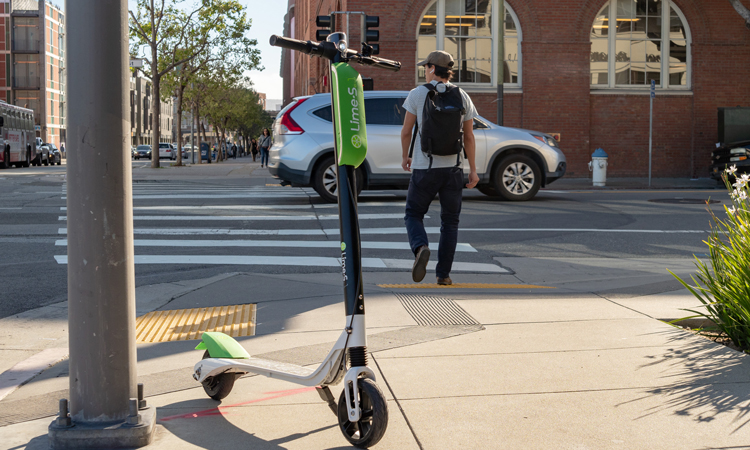San Fran’s mobility plans: a proactive approach to managing mobility
- Like
- Digg
- Del
- Tumblr
- VKontakte
- Buffer
- Love This
- Odnoklassniki
- Meneame
- Blogger
- Amazon
- Yahoo Mail
- Gmail
- AOL
- Newsvine
- HackerNews
- Evernote
- MySpace
- Mail.ru
- Viadeo
- Line
- Comments
- Yummly
- SMS
- Viber
- Telegram
- Subscribe
- Skype
- Facebook Messenger
- Kakao
- LiveJournal
- Yammer
- Edgar
- Fintel
- Mix
- Instapaper
- Copy Link
Posted: 24 August 2018 | Carol Schweiger - Schweiger Consulting | No comments yet
President of Schweiger Consulting and Chairperson of the New England Intelligent Transportation Society, Carol Schweiger, details San Francisco’s proactive, and therefore successful, strategy in introducing and managing new mobility services.


San Francisco is at the centre of the mobility revolution and, according to A.T. Kearney1, considered a leader in disruptive innovation. In the transport realm, several new services were pioneered in San Francisco, including UberCab, which became Uber, Chariot, a microtransit solution now owned by Ford, and Spin, which loans out electric scooters. Therefore, it was not surprising that San Francisco’s Municipal Transportation Agency (SFMTA) established the Office of Innovation in 2015.
Timothy Papandreou became the Director of this office and focused on improving mobility by utilising SFMTA’s City Transportation Platform model. “Papandreou’s working theory of San Francisco’s ‘City Transportation Platform’ look[ed] at using new policies and partnerships across four major areas: customer experience, service providers, new technologies and physical environment. The platform environment establish[ed] a key set of requirements and if new mobility providers meet them they get to ‘play’ and access the city’s public rights of way – such as lanes, sidewalks, transit stations, parking spaces, docking stations, etc. The requirements focus on making sure all potential transportation providers meet key safety, affordability, availability, interoperability and sustainability goals”2.
Inventory of mobility services and technologies
A few years after the creation of SFMTA’s Office of Innovation, the San Francisco County Transportation Authority (SFCTA) worked with SFMTA and other members of the public and private sectors to continue the SFMTA’s efforts to improve mobility. The first step was to develop an inventory of ‘emerging’ mobility services and technologies. According to SFCTA and SFMTA, “an Emerging Mobility Service or Technology is one that automates three or more of the following services:
- Driving
- Routing
- Reservations/orders
- Vehicle tracking
- Billing
- Customer feedback
- Matching/sharing
- Crowd-sourced routing
- (Un)locking.”3
This inventory identified nine emerging mobility services and technologies, detailed below:4
|
Type of service |
Examples of service providers (bolded companies are active in San Francisco) |
|
Electric standing scooter-sharing |
Bird, Lime, Spin* |
|
Bike-sharing |
B-Cycle, Bluegogo, Bay Area Bike Share/Ford GoBike (operated by Motivate), JUMP Bike (operated by Social Bicycles), Limebike, Scoot, Zagster |
|
Scooter-sharing |
Renault’s Twizy, Scoot, Toyota’s iRoad |
|
Car-sharing |
Car2go, Getaround, GIG, Maven, Zipcar |
|
Ride-sharing |
Blablacar, Scoop, Tripda, Waze Carpool |
|
Ride-hailing |
Flywheel, Lyft, Uber, Via |
|
Microtransit |
Bridj, Chariot, Leap, Night School, Via** |
|
Courier network services |
Amazon’s Flex, Caviar, FedEx, Good Eggs, Grubhub, Instacart, Postmates, Omni, UPS |
|
Autonomous vehicles (technology) |
Cruise/GM, EasyMile, Ford, Lyft, Mercedes, Renault/Nissan, Navia, Nvidia, Tesla, Uber, Waymo, Zoox*** |
|
Robots and drones (technology) |
Amazon Prime Air, Marble, Starship |
The 10 Guiding Principles
SFCTA and SFMTA developed and adopted “10 Guiding Principles to serve [primarily] as a framework for evaluating these services and technologies. If a service provider (SP) or technology does not meet these Guiding Principles, the [SFCTA] and SFMTA will work with the SP to meet the principles or limit their access to city resources.”5
These Guiding Principles naturally follow the SFMTA City Transportation Platform in the following way:
- Collaboration: required among mobility SPs, the city and the public to ensure continual transport improvement
- Safety: SPs must be consistent with the city and county’s safety goals
- Transit: services must complement and help to satisfy the needs of public transport and other high occupancy modes
- Congestion: SPs must consider their impact on traffic, public transport, mode choice and roadway safety
- Sustainability: SPs must help attain the city’s greenhouse gas (GHG) emissions and reduction goals and promote non-auto modes
- Equitable access: services must be accessible to all people “regardless of age, race, colour, gender, sexual orientation and identity, national origin, religion” and other demographics such as income and residential location
- Accountability: SPs must share data for the city and public to determine the services’ benefits and impacts on transport and whether or not the services’ meet the city and county’s transport goals
- Labour: SPs must be consistent with fair labour and pay practices and policies
- Disabled access: services must be accessible to people with reduced mobility, ensuring that they receive the same or comparable level of access as persons without disabilities
- Financial impact: services are encouraged to demonstrate having a positive financial impact on transport investments.


The Guiding Principles facilitated the legislation necessary to manage the new electric scooters that appeared in San Francisco in March 2018 without any prior approval by the city
Once the Guiding Principles were adopted, SFCTA and SFMTA evaluated how the services and technologies identified in the inventory “align with the city’s long-range transportation goals in relation to a healthy environment, livability, economic competitiveness and world-class infrastructure, and through transportation lenses such as equity and affordability.”4
The evaluation results
Pilots and permits lead to better performance
An example of this is the situation in which the city found itself in March 2018 when several electric scooter companies began operating with no prior approval. On 1 May 2018, the SFMTA Board of Directors “voted to offer five companies a permit to each operate up to 500 scooters, allowing for a total of 2,500 scooters on [San Francisco] streets.”6
Inadequate data
Many private mobility companies do not release data that describe their operations, making it very challenging to determine the impact of these services on the transportation network. In a study conducted by the Metropolitan Area Planning Council (MAPC), this issue required that the use of ride-hailing be determined by surveying customers of these services. “Public analysis of the effects of ride-hailing services on the transportation system has been hindered by a scarcity of meaningful data made available by the ride-hailing companies.”7
Opportunities for equitable access
Overall, emerging mobility services covered the time periods and locations that are not well-served by public transport.
Conflicts with public transit
Emerging mobility services in San Francisco were in some cases competing with public transport services rather than supporting them.
Impacts on safety
Safety-related issues were cited, including those that directly affect vulnerable road users and cause distracted driving.
Impacts on congestion
The lack of data from SPs meant that not all impacts of these services could be evaluated. SPs have not been working cooperatively with the city to manage the use of right-of-way and curbs. On the positive side, the use of some mobility services result in users driving less.
As a result, seven recommendations were made:
- The city should proactively partner with mobility providers to create ways to address unmet transportation needs
- Emerging mobility data collection and management should be consolidated and travel behaviour research should be conducted
- Permit, regulatory and impact fees should be charged to mitigate the impacts of new mobility services and permits should require that SPs make operational data available
- Accessibility and equity gaps should be identified by determining who is using emerging mobility services and for what purpose
- SFCTA and SFMTA should study issues such as the financial impacts of mobility services on public transport
- Regulation enforcement should be increased and a Vision Zero8 study conducted to determine the contribution of emerging mobility services to crashes and fatalities
- Curb management and pricing should be piloted with mobility services and street design should reflect the goal of lowering conflicts between emerging mobility services and other road/street users.
Applications and lessons learned


One of San Francisco’s ‘transit only’ lanes
Copyright: Carol Schweiger
So what applications do these Guiding Principles have in other urban areas that are coping with new and existing mobility services and what are the lessons learned to date in San Francisco? Overall, without the vision of the first SFMTA Office of Innovation Director and the City Transportation Platform framework, it would have been challenging to address the issues resulting from the operations of mobility services and technologies. New policies and legislation were required, as were the identification and recognition of the impacts of these services on the transport network.
U.S. cities that have established similar offices to improve and manage mobility services include Los Angeles Metro’s Office of Extraordinary Innovation, Detroit Mayor’s Office of Mobility Innovation, City of Pittsburgh’s (Pennsylvania) Department of Mobility and Infrastructure, City of Austin (Texas) Transportation Department Assistant Director, Smart Mobility, City of Boston’s (Massachusetts) Office of New Urban Mechanics and Seattle Department of Transportation (SDOT) New Mobility Program. While none of these have the same framework as SFCTA and SFMTA within which mobility services and technologies are addressed, they each have similar goals and objectives.
For example, the principles and approach to mobility innovations, developed in conjunction with King County Metro (the public transport agency in Seattle) in its New Mobility Program cover safety, equity, accessibility, clean mobility and design for customer satisfaction9. Furthermore, SDOT developed the New Mobility Playbook10, which contains five ‘plays’ to improve and manage emerging mobility solutions:
- PLAY 1: ensure new mobility delivers a fair and just transportation system for all
- PLAY 2: enable safer, more active and people-first uses of the public right of way
- PLAY 3: reorganise and retool SDOT to manage innovation and data
- PLAY 4: build new information and data infrastructure so new services can ‘plug-and-play’
- PLAY 5: anticipate, adapt to and leverage innovative and disruptive transportation technologies.
While SFCTA’s Emerging Mobility effort is on-going, there are several lessons learned from the development and application of the Guiding Principles. Perhaps one of the most significant lessons was that the Guiding Principles facilitated the legislation necessary to manage the new electric scooters that appeared in San Francisco in March 2018 without any prior approval by the city. The Guiding Principles have allowed San Francisco to be proactive in managing mobility services and evaluating their impact on the transport network. This approach could be very helpful to other urban areas to better integrate these services into the transport ecosystem and ensure that their impacts are measurable and lead to improved mobility for all travellers.
References
- https://www.slideshare.net/atkearney/at-kearney-global-cities-2017-leaders-in-a-world-of-disruptive-innovations
- Debs Schrimmer, “A First Look at SFMTA’s Office of Innovation,” Medium, Feb 8, 2016, https://medium.com/@debsarctica/a-first-look-at-sfmta-s-office-of-innovation-1ef725e764ae
- https://www.sfcta.org/emerging-mobility/inventory
- SFCTA, Emerging Mobility Evaluation Report: Evaluating Emerging Mobility Services and Technologies in San Francisco, Draft, April 2018, page I, https://www.sfmta.com/sites/default/files/reports-and-documents/2018/05/5-15-18_item_12_emerging_mobility_evaluation_report.pdf
- https://www.sfcta.org/emerging-mobility/principles
- Lyanne Melendez, “Powered scooters to be regulated in San Francisco,” KGO, May 02, 2018, http://abc7news.com/traffic/powered-scooters-to-be-regulated-in-san-francisco/3415717/
- https://www.mapc.org/farechoices/
- Vision Zero is a strategy to eliminate all traffic fatalities and severe injuries, while increasing safe, healthy, equitable mobility for all, according to the Vision Zero Network.
- http://www.seattle.gov/transportation/projects-and-programs/programs/new-mobility-program
- SDOT, New Mobility Playbook, Version 1.0, September 2017, http://www.seattle.gov/Documents/Departments/SDOT/NewMobilityProgram/NewMobility_Playbook_9.2017.pdf
Biography


Related topics
Fleet Management & Maintenance, Sustainable Urban Transport, Transport Governance & Policy
Related cities
San Francisco, United States of America
Related organisations
Schweiger Consulting LLC
Related people
Carol Schweiger







